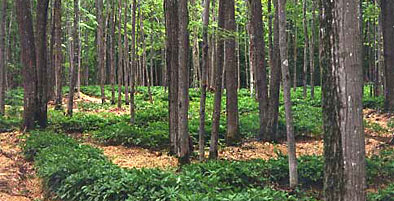Robert Eidus, owner and operator of Eagle Feather Organic Farm, explains the ecology of ginseng, goldenseal, trillium, and ramps. In order to successfully grow these forest medicinals, edibles, and decorative plants, it’s imperative to understand their relationship to their environment and in some cases, to each other. While their rate and success of propagation in the wild are different, they enjoy similar forest ecosystems. Loamy soil that drains well, often related to slope, in addition to the shade of deciduous forests are, in a nutshell, the preferred habitat of these forest plants.
Raised seed beds beneath the forest canopy can give ginseng seeds an advantage. By constructing the beds to certain dimensions, screens of the same size can be placed over the planted seeds to protect them from turkeys, mice, voles, and other forest dwellers who feed on the seeds. Robert Eidus, owner of Eagle Feather Organic Farm, explains how he plants the seeds, covers them with leaf litter, fits the screen to the raised beds and then finishes by adding another layer of leaves. The screen must be removed in the spring before the seeds sprout. If the screen is left in place, the seedlings will most likely die. The leaves are removed in the spring and straw is put down which allows the ginseng seedlings an easier medium to grow through.
Ginseng is very susceptible to fungus and as a result, it is sprayed with a variety of fungicides to reduce the chances of the plant building up a tolerance to just one chemical. Consumed as a holistic herb taken for general well-being, the residue of fungicides on the root is considered a harmful additive which detracts from its healing properties. Robert Eidus, owner of Eagle Feather Organic Farm, explains how ginseng is not regulated for the presence of fungicides and as a result, much of the ginseng that is sold for public consumption is tainted with harmful chemicals. There is an alternative form of ginseng and that is in a wild-grown or wild-simulated root that may or may not need fungicides. This generally depends on how thickly the ginseng is grown beneath the forest canopy. Robert explains an organic method he uses to ‘immunize’ ginseng against the soil-born fungus. By steeping goldenseal roots and rhizomes in hot water, he makes a concentrated tea that he uses to wash the soil in the raised beds. Once the soil has been washed with the antibacterial and antimicrobial properties of goldenseal, the ginseng seeds are then planted. To combat air-born fungus, Robert sprays the ginseng seedlings with horsetail. After it rains, a new coating of horsetail spray should be applied. While this method may be more feasible for smaller patches of ginseng, growing ginseng and goldenseal together may help reduce the spread of fungus such as phytophthora.
Robert Eidus explains how to transplant ginseng seedlings with minimum irritation to the plant. These seedlings are sold at the Asheville Herb Festival. Forest grown medicinal herbs can be sold as dry product, seedlings, rootlets, or as value-added products. When sold as a seedling, as pictured in this video, the plant should only be contained in a pot for a month at most. Ginseng seedlings do not fare well if left in plastic pots for too long. The seedlings should be kept moist and in shade while they are being held for market sale.
Robert Eidus, Owner of Eagle Feather Organic Farm, gives advice on how to begin growing and selling forest medicinal herbs. Number one: “Don’t cut down your trees.” We look at stratification – the best method for increasing ginseng’s propagation rate. We follow up with the importance of having a business plan before attempting to supplement income through forest-based medicinal plant production, and we finish with a few bits of advice on cutting costs. Plastic pots can often be obtained for free from other growers or nurseries and leaves can be gathered in the fall once they’re put out for trash collection. However, be careful of collecting any invasive species that may be tossed in with the leaf pile. Leaves contribute to forest soil and can be combined with other organic additives and composted to be used in raised beds and for potted plants.
In this video, we take a look at the annual Asheville Herb Festival where 60+ vendors come out to sell their fruit trees, vegetable plants, and medicinal herbs. Robert Eidus, owner of Eagle Feather Organic Farm, Joe Hollis from Mountain Gardens, and several other organic herbalists are in attendance. This video provides a glimpse of the market place and can give budding herbalists an idea of how to market their products. We also discuss the importance of reseeding these plants that are often over-harvested from the wild. Forest farming these medicinal herbs helps to ensure a sustainable supply for public consumption.
